
Plan Target: create pathway to decarbonization.

Plan Target: 2% annual energy use reduction, 100% clean electricity by 2025
In 2013, UC President Napolitano declared that UC will be the first research university to achieve carbon neutrality, with a target date of 2025. Now to accelerate its transition away from fossil fuels, the University of California has adopted new, stronger climate action goals that prioritize direct emission reductions, limit the use of carbon offsets and align UC’s climate goals with those of the state of California. To support these goals, UCLA is undertaking a decarbonization study, funded by the State of California. You can follow the progress and get engaged on the Decarbonization Study Page.
Since 1990 UCLA has grown almost 40%, adding nearly eight million square feet to the campus footprint, the equivalent of over 4,000 houses.
Over the last two decades, UCLA research awards and grants have exploded from less than $300 million to over one billion dollars annually. One would expect with such remarkable growth to see a parallel increase in greenhouse gas emissions. Yet, through a combination of energy efficiency, renewable energy, sustainable transportation programs and offsets, UCLA reduced greenhouse gas emissions to below 1990 levels in 2014, achieving the 2020 goal six years ahead of schedule.

Climate Projects
UCLA Facilities Management has a Smart Buildings & Labs Program that assess and retrofits buildings to operate with intelligence and align with campus conservation initiatives.
In 2019 the UCLA Santa Monica Medical Center transitioned to 100% renewable electricity through the Clean Power Alliance.
UCLA signed a historic renewable rate agreement in October 2019 with the LA Department of Water and Power (LADWP) that will provide 10 MW off-site solar energy. We will also pursue significant on-site solar (4-9 MW) as part of LADWP Feed-in-Tariff program.
UCLA has committed to 90,000 MWh of Renewable Energy Credits (RECs) annually through UC renewable energy projects beginning in 2022.
The university continues to grow, so UCLA has developed a Carbon Neutrality Plan (update in progress). UCLA recognizes the urgency of the climate crisis and that carbon neutrality in 2025 is not the end goal, but a step on its journey to decarbonization and a clean energy future. UCLA will examine the feasibility of infrastructure transformations and continue to adapt climate actions and plans.
Planning Documents
Annual Reports
- UCOP Annual Sustainability Reports
- California Air Resources Board Reports
- 2006 Third-Party Verified GHG Emissions
- 2007 Third-Party Verified GHG Emissions
- 2009 Third-Party Verified GHG Emissions
- 2010 Third-Party Verified GHG Emissions
- 2011 Third-Party Verified GHG Emissions
- 2012 Third-Party Verified GHG Emissions
- 2013 Third-Party Verified GHG Emissions
- 2014 Third-Party Verified GHG Emissions
- 2015 Third-Party Verified GHG Emissions
- 2016 Third-Party Verified GHG Emissions
- 2017 Third-Party Verified GHG Emissions
- 2018 Third-Party Verified GHG Emissions
- 2019 Third-Party Verified GHG Emissions
- 2020 Third-Party Verified GHG Emissions
- 2021 Third-Party Verified GHG Emissions
Media and Awards
- UCLA Newsroom: Researchers receive Department of Energy grant to transform carbon dioxide into construction materials
- UCLA Newsroom: UCLA receives 2015 Energy Efficiency and Sustainability Best Practice Awards
- UCLA Newsroom: Students compete to see who is biggest energy miser
- Daily Bruin: Financed by the Green Initiative Fund, Ackerman Union receives new solar panels
